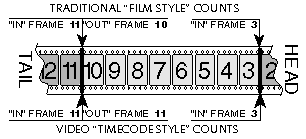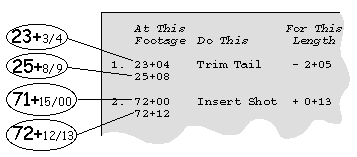Dealing with Avid Change Notes for Fun and Profit
by Andy Somers
With the march toward newer and better technologies we sometimes lose a ‘traditional’ method of doing something and replace it with a ‘new and improved’ one. Unfortunately, the new way may not be so improved – often it’s ‘de-enhanced’. One good example of these de-enhancements are those lovely change notes that the Avid spews out.
In a meeting about a year ago, the Avid engineers responsible for the film options seemed very receptive to making several major changes to the program…sometime in the future. Until they actually make these fixes, we’ll need to deal with the notes as generated. Here’s a quick guide to help you get the most out of them with the least pain!
2 + 2 =3 ??
The Mysteries Of Counting Film Frames Revealed
The first issue I’d like to address is the confusion caused by the manner in which counts are printed on the change note. If your background includes Moviolas and sync blocks they may not be a total mystery, but if your experience is mainly with video and/or digital audio workstations, then some of these numbers may not make much sense.
 |
|
|
|
|
|
|
|
In the world of film, we usually measure using whole frames. The end of a shot is indicated as the last frame of the shot, not the first frame of the following shot. This is sometimes referred to as an ‘inside/inside’ count.
This difference would never have caused a problem except for the introduction of Digital Audio Workstations. DAWs handle both footage and timecode the same way: frame counts are handled in video. That is, the "head" or "in" of an edit is counted at the leading edge of the frame, and the "tail" or "out" of an edit is counted as the leading edge of the next frame.
When we used to specify a frame edge in film, the film assistant would often write the change note so that a particular footage would be written like this: 263 +12/13, which means the frame edge between 263’+12 frames, and 263’+13 frames. This removed any ambiguity about which frame-line to make the cut on.
 |
|
|
|
|
|
|
|
The upshot is that the best way to interpret Avid notes is to use the IN or FROM point, and then set a RANGE using the change list’s "For This Length" column. Thus, for the change shown in figure two you’d goto 23’+4 on your DAW, and then add 2’+5 (the amount of the change) you’ll end up at 25+9, not the 25+8 as indicated in the Avid change note. In other words, you must always add one frame to the Avid’s "out" number when you are working on a DAW.
(This is the same counting problem that sometimes results in tail pops being placed incorrectly. The leading edge of the tail pop should be 3’+0 from the leading edge of the LFOP. However, it is often mistakenly placed 3’+0 after the trailing edge of the LFOP.)
You Want Fries with That?
How To Order A Customized Change List From The Picture Department
One thing that most Avid assistants know, but that many sound editors may not know, is that the Avid has dozens of options for configuring the way that change lists print out. A little communication with the picture department is all that’s needed to get a set of lists with the information that’s most useful to you.
For example, on a picture change note to be used by sound effects, foley and music editors, we would typically like to see the following:
- The change number.
- The footage where the change
occurs.
- What the change is.
- The length of the change.
- Either the KEY numbers or the INK
numbers relating to the change, depending on which is
burned into the video. If you’ve burned in Key
numbers, then the change list needs Key numbers on
it.
- The scene and take number. You can
use clip name only as long as it always contains the
scene and take information.
- The running total of the
changes.
What we typically don’t need are any extraneous bits of data. We don’t need the "conform by timecode" information, we don’t need sound roll info or sound timecode, and we definitely don’t need icons! All these features take up space on the page, and make the note more confusing to look at.
One variable that is a "definite maybe" is the "Combine All Deletions" option. If the majority of the changes between each version of the sequence involve large wholesale deletions of scenes, as you’ll have early in the post-production process, then it’s good to have this option turned on. If on the other hand, you’re near the final and the changes are mainly small nips and tucks with a number of length-for-length changes such as you’d have when you replace an Avid temp optical with a final film optical, then it’s good to have this option off. The reason is that you want all the length-for-length changes to be apparent so that the sound editor sees clearly that no real change was made.
If this option is on, and you have 4 opticals in a row, the change note will state "Delete 4 shots" as a single event and then indicate 4 separate inserts–it may not be completely clear that each of these shots is just an optical swap. With the combine option off, each length- for-length swap is presented separately, making it more obvious that no real change was made.
When making sound change notes use the same information as noted above, except that instead of Key or ink numbers, use sound roll numbers and sound roll timecode. Also keep in mind that when a conform is done on a Fairlight or Pro Tools, it’s typically done to all tracks at once. Because a dialog editor is not going to stay with the track assignments used by the picture editor in the Avid (typically using a much wider track assignment) he or she will likely use only the ‘track one’ change notes to perform the bulk changes on a reel. As a result, it’s important that track one contains only production audio (no temp sfx or adr).
Also, picture editors should be aware that moving sound clips from one track to another is not communicated in the Avid’s change note and can result in confusion for the sound department. This problem has often made the ‘track one’ change note meaningless, forcing many dialog editors to use the picture notes instead. Nevertheless, I think most dialog editors would prefer a working track one note to a picture note, since the picture note doesn’t tell the whole story as to how the changes affect the dialog.
Finally, it‘s very important that the running total in the far right column be printed on either picture or track notes. This very useful information is often lost during printing. To make sure that it is shown, always print the change notes in landscape, not portrait, mode. Also, make sure the font size is small enough to fit all the columns on the page.
Calling Bartleby the Scrivener!
The Need For Manual Notations
The Avid change note program does not provide a few other important pieces of information and it’s important that these be manually written on the change note prior to handing it over to the sound department.
First, the LFOP! (That’s "Last Frame of Picture" for those of you who work with video.) Neither the "old duration" nor the "new duration" noted at the end of the change note are the LFOP – even if you remove all tail leader elements. This is due to the same counting problem described above. It’s important to accurately hand-write the OLD LFOP and NEW LFOP on the change note.
Second, the Avid does not specifically state what version the change is coming from and going to! To avoid confusion, write this on the note. For example, "This change note goes from the 3/8 version to the 3/24 version".
Deconstructing Hairy Change Notes
A Quick Workaround
One of the most irritating aspects of Avid’s current implementation is the way the change program note handles certain types of moves. (They have promised to fix this at some time in the future.) If a scene or shot is moved to a point earlier in the reel, and there are changes between the point where that scene used to live and where it’s going, the Avid change note will deconstruct the reel into a massive series of moves. All that is really happening is a single move forward followed by a few changes. This happens because at present, the Avid doesn’t understand the concept of moving a scene to a point earlier in the reel! The change note program was only written with the capability of moving shots later.
If you come across this situation, it is possible to fake the Avid into generating a list that’s a bit simpler. The workaround goes like this:
- Determine which shots are being
moved earlier.
- In the ‘old’ version of
the Avid sequence, replace each of these shots with
filler. (Obviously, use a copy of the sequence to do
this!) Now, any shots that are moved earlier will be
shown as simple inserts. The point in the reel where
these shots were lifted from will now be shown as
‘delete leader’.
- Finally, make a manual notation
indicating that this deletion of leader is actually a
move to earlier in the reel. Create the notation by
crossing out the words "delete leader" and write "move to
event #" and where it is to go. Then cross out the words
"insert shot" and write "insert from event #" and where
it comes from.
I hope this article has served to illustrate some of the issues regarding change notes. If I can take one parting shot, it’d be really nice if Avid actually took the issues here in the Hollywood community more seriously. The bugs and deficiencies in the change note program have been there for years. It’s a tool that we all must use when working on any feature film today, but the deficiencies in the change note program present a sometimes confusing, and always more complicated-than-needed change note. This creates problems for the sound department. Ultimately it ends up costing money, as frustrated sound editors incur overtime weeding though the changes!
Having said that, happy cutting!
Andrew Somers is a Guild member and a picture editor, sound editor, and mixer.
If you have comments on this article or would like to discuss it further,
contact him viaGeneral Titles & Visual Effects
Reprinted from
The Motion Picture Editors Guild Magazine
Vol. 21, No. 2 - March/April 2000
ARCHIVES HOME
